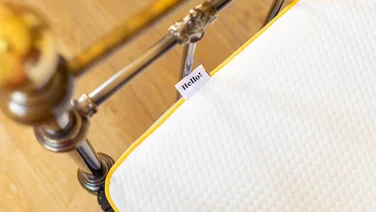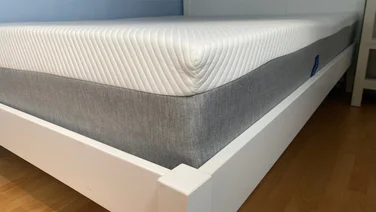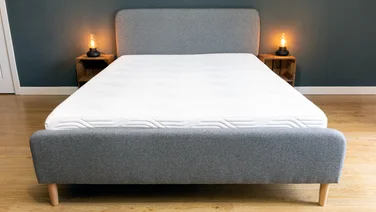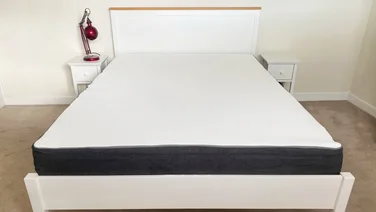To help us provide you with free impartial advice, we may earn a commission if you buy through links on our site. Learn more












- Exceptional comfort and pressure relief for side sleepers
- Surprisingly supportive for back sleepers
- Good temperature regulation
- Edge support is somewhat lacking
- Too soft for stomach sleepers and heavier bodies
The Emma Hybrid Airgrid mattress is the brand’s premium mattress, designed with a “medium soft” feel that makes it one of the best mattresses we’ve tested for those who sleep on their sides. It’s an extremely comfortable and contouring mattress, offering plenty of cushioning at the pressure points around the shoulders, knees and hips. But, despite this softness, the mattress still manages to offer some good support for back sleepers.
I was also highly impressed with the motion transfer and temperature regulation of the Emma Hybrid Airgrid, but the edge support was sadly lacking. It’s not cheap either, with a king costing £1,314 at full price. But if you’re a side sleeper, I think this is one of the best mattresses you can buy, justifying its higher price tag.
What you need to know
The Emma Hybrid Airgrid mattress is Emma’ premium offering. Previously known as the Emma Elite, it’s now had a slight upgrade, and I wanted to see what this new model was like to sleep on.
First things first – how was the delivery service? Emma ships its mattresses to your front door using either UPS, DPD or Rhenus although there is the option to upgrade to premium delivery (with the mattress delivered to a room of your choosing) for £35. The mattress arrived in a box – I had ordered a double size, and it did take a fair amount of effort to get it upstairs. Boxed mattresses are heavy, so I’d recommend investing the extra £35 and getting it delivered to your bedroom.












The Emma Hybrid Airgrid comes vacuum-packed and rolled into its box and it’s worth noting that it did take a while to expand fully. I had it expanding by 10am in the morning and I’d say it was at least 8pm before it had reached a height that I felt happy sleeping on. At 27cm deep, the Emma is just a little shorter than the DreamCloud Luxury Hybrid and Simba Hybrid Pro at 28cm, but it certainly looks and feels like a luxury mattress. There was a slight off-gassing smell that lingered for around 24 hours but it wasn’t particularly strong and opening windows soon helped to dissipate this.












Like the best hybrid mattresses, the Airgrid is made from a combination of foams and coils. Starting at the top, there’s a removable and washable “UltraDry” top cover that’s designed to be breathable, followed by the aforementioned “AirGrid”. This is made from a stretchy, gridded “Hyper-Elastic Polymer” material that, according to the brand, is designed to flex with the sleeper to add a little bounce to the bed. Up next is a layer of “MemoryAdapt” foam designed to contour to your body shape, followed by a low-density foam layer and a layer of “SupportBase” foam for pressure relief and firmness. Last up is the “InfinitySpring” pocket sprung base, which helps with spinal alignment and structure for the mattress. An anti-slip cover at the very bottom helps keep the whole mattress in place on the bed base.












I’d recommend rotating the mattress regularly to keep dips from forming but be aware that this is quite a heavy mattress. Depending on the size you buy, it could weigh from 24.3kg up to 49.5kg, so rotating is going to be a two-person job. For peace of mind the mattress also comes with a 200-night trial and a 10-year guarantee.
Price and competition
There’s no getting away from the fact that this is a pricey mattress. Like many mattress brands these days, there’s usually a discount to be found, but you can expect to pay £679 for a single at full price. This rises to £1,008 for a double, £1,314 for a king and £1,667 for a super king. This is comparable with many of its rivals. The Panda Hybrid Bamboo Pro, for instance, retails at £1,390 (king), while the Eve Wunderflip Premium Hybrid is £1,099. One of our favourite hybrid mattresses, the Simba Hybrid Pro, will cost you £1,299 in a king size.
There are other cheaper picks for side sleepers of course, with the all-foam Nectar Memory Foam mattress costing £549 for a king (I should note that hybrids are often a better choice of support and longevity). Emma’s own Hybrid Premium mattress is also significantly cheaper, at £639 in a king size, as is the Hybrid Thermosync at £918.
Comfort and performance
I’ll admit that I didn’t have high expectations of the Hybrid Airgrid. It’s labelled as a medium soft mattress, and my preference has always been for a medium firm to firm option. However, I was pleasantly surprised by both the comfort and support of the Emma, particularly when I was sleeping on my side. The cushioning and pressure relief around my shoulders, hips and knees was exceptional and I appreciated the gentle contouring and slightly softer top layers. As a lightweight sleeper I often don’t sink into a mattress far enough to get this pressure relief, so the Airgrid was a pleasant surprise. I was also impressed by the support provided for side sleepers, finding that I didn’t ‘dip’ too far into the mattress, with my spine kept aligned and supported. I would suggest that the firmness is medium rather than medium soft.












I’m a combination sleeper, so I often spend time sleeping on my back as well as my side. I think a lot of back sleepers will also be impressed by the support underneath the cushioning top layers but as a lower back pain sufferer, I did feel that there wasn’t quite enough lumbar support for my liking. If you do suffer with aches and pains, I’d recommend investing in one of the best mattresses for back pain instead. I’d also suggest that this mattress is best suited to lightweight and average weight sleepers – those of a heavier build are unlikely to find it supportive or firm enough to stop them sinking too far in. Stomach sleepers will also struggle – I’d suggest checking out the Origin Hybrid mattress instead.
I also conducted tests with weights to see the sinkage of the mattress, with 10kg of weights causing the mattress to sink by 17mm near the centre. This gives enough cloud-like comfort at the top with plenty of support underneath. Motion isolation is excellent and you’re unlikely to be disturbed by a restless partner, but you will struggle to use the full width of the mattress as the edge support is somewhat woeful. 10kg of weights gave a sinkage of 22mm but also a tilt angle of -4 – lying on the edge or sitting on the bed doesn’t feel particularly secure and I felt that I was tipping at an angle. This really is the only flaw of this mattress and if you get a big enough size, it might not be a problem. But for my husband and I sharing a double, it was definitely noticeable.












Lastly, I conducted tests to see how well the mattress dealt with heat and whether it would keep sleepers cool at night. Emma markets the Hybrid Airgrid as a good choice for hot sleepers, claiming that the AirGrid material itself helps to keep the temperature consistent and comfortable throughout the night. But did it live up to this promise during testing? My husband is a hot sleeper, and he found that the Airgrid provided excellent temperature regulation, remaining comfortable throughout the night.
To further test Emma’s credentials as a cooling mattress, I conducted some tests with a heat pad and a thermocouple probe. Once the temperature had stabilised and dropped to 50°C, the pad was removed, and readings were taken over 10 minutes. After one minute, the temperature had dropped to 27.2°C and after 10 minutes, it was down to 23.8°C. This isn’t quite as impressive as the Emma Hybrid Thermosync mattress, which dropped to 22°C in the same period, but it does suggest that the Airgrid is effective when it comes to temperature regulation.












In addition to the above, I tested how the mattress handled against body temperature, by sitting on the mattress with a thermocouple placed underneath me, until the temperature reached 30°C. After 10 minutes, the temperature dropped to 21.9°C, which is another impressive result. For comparison, the Dreams TheraPur – an ideal pick for hot sleepers – dropped to a comparable 20.4°C in the same test, so I’d argue that the Airgrid will do a good job of keeping sleepers cool at night.
Emma Hybrid Airgrid mattress review: Verdict
Is this the best mattress for side sleepers? I think it’s definitely my top pick – the cushioning comfort and excellent support it offers when you’re sleeping on your side are hard to beat. And for lighter back sleepers, this mattress could also be a great option. It’s surprisingly supportive considering its softer top layers and I slept well on my side.
That said, I don’t think this mattress is firm enough for heavier or stomach sleepers and lumbar support is a little lacking for back pain sufferers. Edge support was also disappointing and really is the only thing that prevented this mattress from being awarded five stars. It’s also very expensive but, overall, I think the Emma justifies its price tag. It offers excellent comfort and support, along with great temperature regulation and motion isolation. Side sleepers won’t regret investing.






